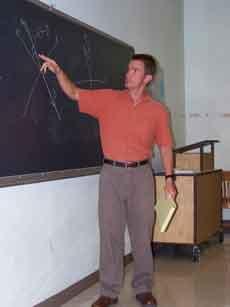With the assistance of the Internet and a NASA telescope in space, Chad Young, assistant professor of physics, has been conducting research on star formations for the past six years and has published five papers on this subject matter within the last year. About three years ago, Young led a team of astronomers at Texas University at Austin that discovered the first forming brown dwarf. He published articles based on the findings and research done on star formations with this team. There have been about a half-dozen of these forming brown dwarfs discovered since then, Young said.
“Brown dwarfs appear to be forming the same way as stars, however they are not technically stars because they are not massive enough,” Young said.
Observing the formation of stars in our galaxy paves the way to discovering how our star, the sun, has become what it is today, Young said. Young’s research examined low-temperature physical processes, the propagation of radiation through dense environments, the roles of turbulence in gravitational collapse and many other things, he said.
“Man aspires to know his origins,” Young said.
Young is Nicholls’ only astronomer in the physical science department.
Astronomy classes may be offered in the next catalog, Young said.
“I know many students would be interested in an assortment of astronomy courses,” Young said. “If a vacant physics position is filled in the future, these courses will probably be offered.”
A two-semester sequence in astronomy covering the history of astronomy, the solar system, the birth, lives and deaths of stars, quasars (a distant big black hole), astrobiology and the search for extra-terrestrial life is an idea Young hopes to implement at Nicholls.
“I would also like to offer an upper level class in astrochemistry, which would examine the chemical processes that occur in stars and the interstellar medium, the space between stars, and the methods used to detect these processes,” Young said.
Young now teaches general and basic physics with lab-oriented classes. General physics is the calculus-based physics series, and basic physics is the trigonometry-based physics series, Young said.








